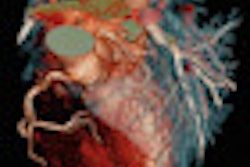Radiologists at the University of Colorado Hospital in Denver have developed a reference card designed to give patients and referring physicians some perspective about the risks of medical radiation, according to an article in the April issue of the Journal of the American College of Radiology.
The Adult Dose-Risk Smartcard is a convenient, pocket-sized reference card intended to facilitate radiation risk consultations and improve patient satisfaction by simplifying essential facts on radiation dose and risk to a level of understanding by referring physicians and patients. The paper-based card can be folded and carried by patients or referring physicians.
To put doses and risks in perspective, the reference card permits the comparison of effective doses from various radiological examinations to natural background radiation levels. These include 12 common radiographic procedures, 11 types of CT examinations including virtual colonoscopy and coronary angiography, seven interventional radiology procedures, and 31 nuclear medicine exams (JACR, 2012, Vol. 9:4, pp. 290-293).
The card also provides a color-coded scale categorizing risks of a fatal radiation-induced cancer, and permits comparison to risk of death from other causes. Most estimates are based on the 2007 recommendations of the International Commission on Radiological Protection (ICRP), the most recent such report published.
The color coding is similar to the radiation dose scale in the ACR Appropriateness Criteria relative radiation level designation, but is based on fatal cancer induction risk rather than radiation dose.
"We recognize that there may be significant age-dependent and gender-dependent variations in both radiation dose and risk estimates," wrote lead author R. Edward Hendrick, PhD, medical physicist of the University of Colorado's department of radiology.
"The Adult Dose-Risk Smartcard does not attempt to incorporate all of those variations, but instead to communicate a representative estimate of effective does and radiation risks to adults from various radiologic procedures."



















